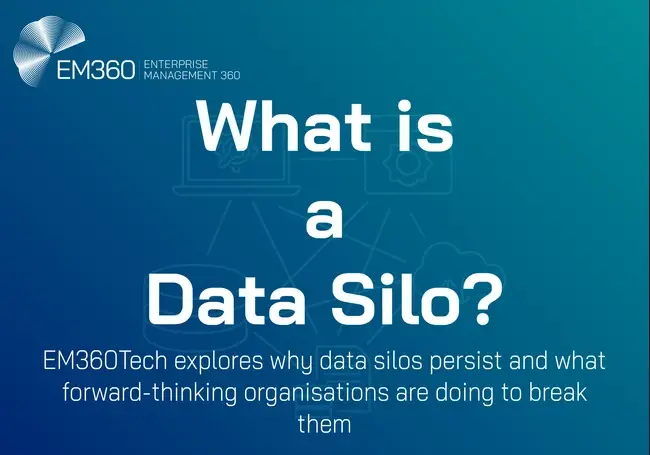
Data Silos Explained: The Hidden Barriers Holding Your Organisation Back
Data is everywhere — but too often, it’s everywhere separately. As organisations race to embrace artificial intelligence (AI), cloud transformation, and real-time insights, they’re hitting a stubborn wall: fragmented, inaccessible information buried across departments, systems, and platforms. Data silos, in other words.
According to DATAVERSITY’s 2024 Trends in Data Management report, 68 per cent of enterprises cite data silos as their number one barrier to extracting value from their information assets. You’d expect this figure to shrink over time, but instead it’s growing.
And the challenge isn’t just technical. It’s strategic. Siloed data slows decisions, weakens security, and blocks innovation at a time when speed and visibility define success. And while many teams know they have a problem, few know how to fix it — or what’s at stake if they don’t.
So what exactly is a data silo, and why is it such a critical obstacle to overcome?
What Is a Data Silo?
A data silo is a repository of information that is controlled by one group or system but inaccessible to others within the same organisation. These silos tend to form when departments collect, store, or manage data independently of each other. And they use tools or platforms that don’t communicate with any of the others in your tech stack.
So your business ends up with isolated pockets of information that are difficult to share or cross-reference. Often without anyone noticing until it’s too late.
Think of it like this: every department is an island, and their data is the cargo stored behind locked port gates. While each island might operate efficiently on its own, the lack of bridges means the organisation as a whole can't move resources — or insights — to where they're needed most.
This kind of data isolation prevents businesses from seeing the full picture. Critical context is lost in the gaps between platforms, and valuable connections between datasets aren’t being made. Marketing can’t see what sales knows, finance has no idea what IT is up to, and operations are making decisions with only half the picture.
In contrast, modern data strategies prioritise democratised access, interoperability, and real-time availability across business units. Breaking down departmental data barriers isn’t just about centralising storage — it’s about giving every team access to the insights they need when they need them, without manual workarounds or delays.
How Do Data Silos Form?
No one sets out to create a data silo. They don’t show up on the roadmap. You won’t see them flagged in a project plan. But they form anyway — quietly and inevitably — as companies grow, merge, modernise, and digitise.
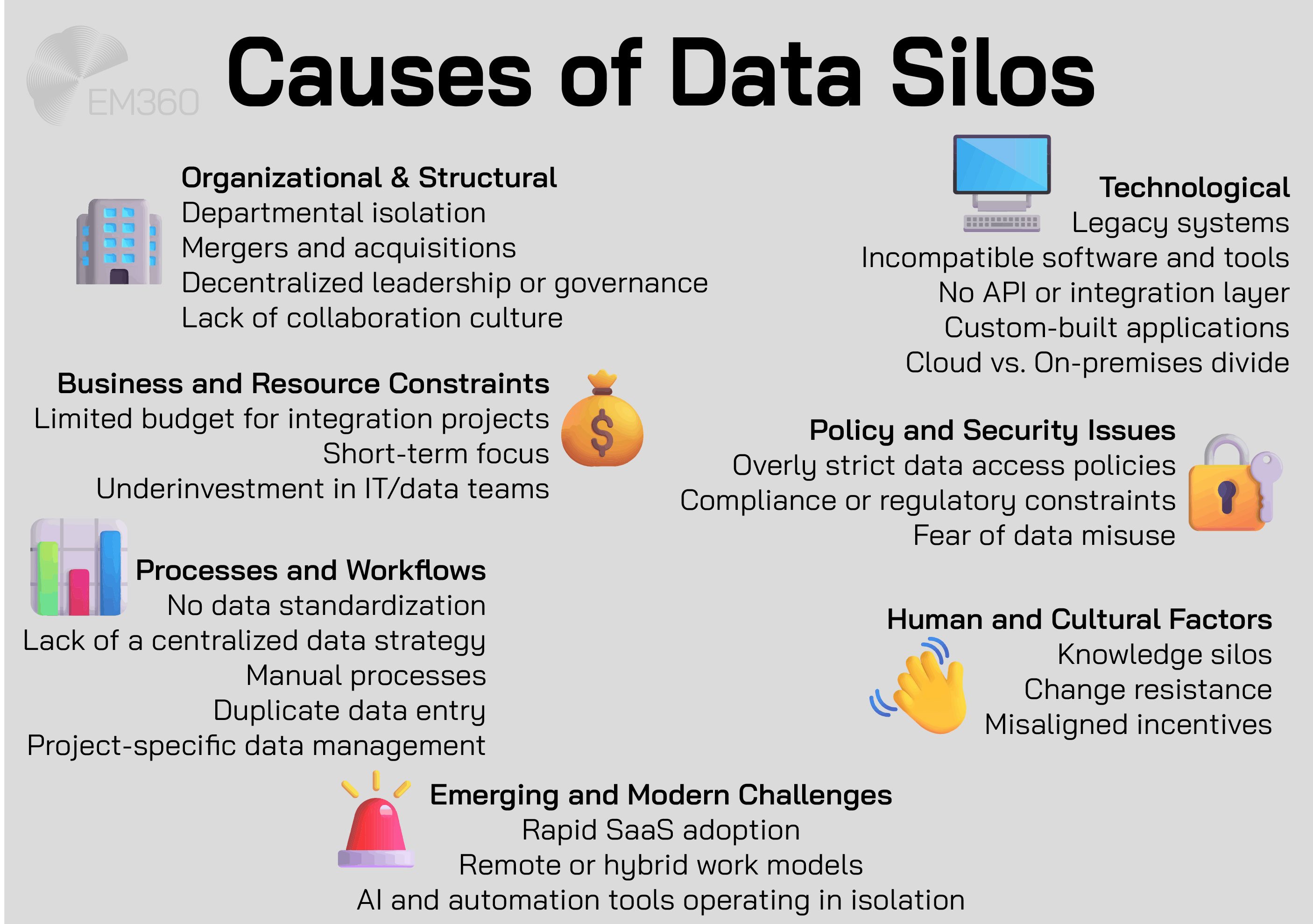
The most common culprit? Legacy infrastructure. Systems that were built for a different era, when point solutions made more sense than platforms. These tools rarely speak to one another — and when they do, it’s usually through expensive custom integrations or brittle workarounds that break the moment you scale.
Then there’s departmental software. Every team has its preferred tools — the CRM Sales won’t give up, the finance system tied to compliance, and the custom HR database built five years ago by someone who’s since left the company. Individually, these systems do their job. But collectively, they create fragmented systems that trap data behind user permissions and application silos.
Mergers and acquisitions only make things worse. Suddenly you’ve got two versions of every system, two sets of naming conventions, and no clear path to consolidation. Integration gets pushed down the priority list in favour of “just making things work”.
And underpinning all of it is a missing foundation — a lack of unified data governance. Without consistent rules for ownership, access, and quality, every team does what works best for them. The result? Organisational silos that keep data fenced off and underused.
This problem isn’t slowing down. It’s accelerating. As more companies adopt hybrid and multi-cloud strategies, their data becomes even more distributed — spread across on-prem environments, cloud platforms, and edge systems, each with their own security models and storage rules.
And if you don’t design with integration in mind from day one, you’re building barriers without realising it.
What’s the Real Impact of Data Silos?
You can’t fix what you can’t see. And when data is buried in silos, most teams can’t see far beyond their own screens.
What starts as a minor inconvenience — an extra step to find a file or a missing data point on a dashboard — quickly compounds into a full-scale operational drag. Inconsistent insights, duplicated efforts, and delayed responses. Decisions get slower, strategies go stale, and no one’s quite sure if they’re working with the right information.
And that’s just the surface.
Productivity, insight, and collaboration challenges
Data silos undermine even the best tech stack. When each department operates with its own reporting tools and metrics — built on isolated, partial data — nothing lines up. KPIs drift. Forecasts break down. Conversations get stuck in clarification mode.
This kind of data inconsistency doesn’t just frustrate analysts — it holds back the business. Marketing doesn’t trust data from the Sales team. Finance has to rebuild reports manually. Operations waste hours chasing numbers that should have been automated from the start.
The result is a long list of operational inefficiencies:
- Redundant data entry
- Delays in reporting
- Conflicting versions of the truth
- Repeated work across teams
And without shared visibility, collaboration suffers. Teams are working hard — just not together. You end up with limited cross-functional visibility, where no one can see the full picture, and every department is optimising for its own view of the world.
Compliance, security, and innovation setbacks
Then there’s the risk. Siloed data isn’t just inefficient — it’s dangerous.
Without unified oversight, you can’t ensure consistent access controls, audit trails, or retention policies. That opens the door to data governance gaps, especially for businesses working under strict regulatory frameworks like GDPR, HIPAA, or SOC 2.
It also creates security silos — blind spots where malicious activity can go undetected because no single system has all the context. According to InfoWeek, 72 per cent of CISOs say siloed data slows threat detection and response times.
And if you’re investing in AI or automation? You’ll hit a wall fast. Machine learning models trained on incomplete or biased data from siloed systems produce flawed outputs. Innovation gets blocked not by the technology but by the compliance fragmentation and data access issues no one resolved beforehand.

It’s a costly mistake. Organisations now spend over US$41.1 billion annually on data management, but the benefits are diluted when data is trapped in disconnected systems.
The bottom line? Silos don’t just waste time. They waste potential.
How to Identify Data Silos in Your Organisation
Before you can solve the problem, you need to see it.
Data silos have a way of hiding in plain sight — especially in large or fast-growing organisations where every team has its own tools, workflows, and reporting structures. But once you know where to look, the signs are hard to miss.
Step one is a data access audit. Who can see what? Which systems are locked down by default? Which teams control their own data, and how easily can others tap into it? If the answers vary widely depending on the department or tool, you’re likely dealing with siloed structures.
Step two is to look for information duplication. Redundant datasets are a major red flag — especially when different versions of the same data are stored in separate apps, with no clear source of truth. You’ll often find these duplicates in spreadsheet exports, one-off reports, and disconnected dashboards that have been built out of necessity rather than strategy.
And the final step is to focus on the human side. Ask your teams:
- Do you trust the data you’re working with?
- Can you get the insights you need without chasing other departments?
- Have you ever made a decision based on missing or outdated data?
Responses to these kinds of questions can reveal the visibility gaps and bottlenecks that dashboards won’t show you.
This isn’t about blame — it’s about clarity. Understanding where your silos are is the first step toward breaking them down. And for data leaders, it’s also the gateway to more strategic conversations about governance, integration, and transformation.
Because once you see the pattern, you can start to change it.
Modern Solutions for Breaking Down Data Silos
Tearing down silos isn’t just a tech decision — it’s a strategic imperative.
Because by the time you notice the costs of fragmentation, you're already paying for them. Missed insights, misaligned teams, and duplicated work are just some of the issues. And with AI, automation, and hybrid infrastructure shaping the future of business, siloed data is more than inefficient — it’s incompatible.
The good news? There are modern approaches built specifically to dismantle these barriers. Not by forcing everything into one system, but by rethinking how data is owned, accessed, and activated across the organisation.
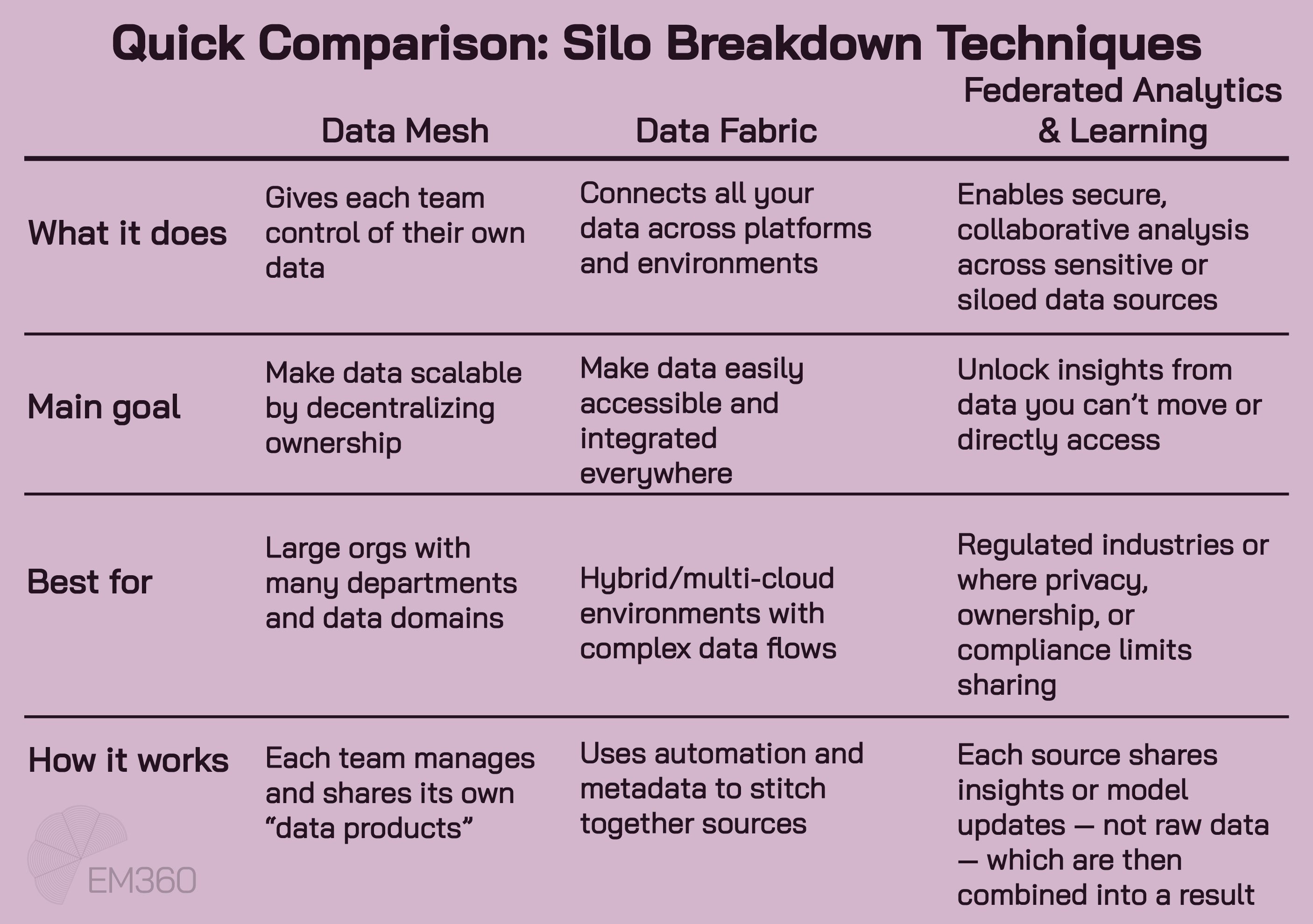
Let’s look at three of the most important shifts.
Data mesh: Decentralised data ownership at scale
Traditional data architecture assumes everything flows to a central team — the engineers who build the pipeline, clean the data, and deliver the dashboards. But that model doesn’t scale. It centralises bottlenecks and keeps business users waiting.
Data mesh flips that logic. It’s a domain-oriented architecture where each business unit owns its own data — not just the access, but the accountability. Teams publish clean, reliable data products that others can discover and use without back-and-forth tickets or custom queries.
This is data product thinking: treating data as something that must be curated, maintained, and served with the same discipline as software.
And with a self-service data infrastructure beneath it — including discovery tools, governance standards, and automation — teams can access what they need without sacrificing security or control.
According to a report by Gartner, there has been a major rise in the enterprise adoption of mesh models as organisations try to overcome central bottlenecks and bring data closer to the teams that use it.
Data fabric: Unified access across distributed systems
Data doesn’t live in one place anymore. It lives across clouds, on-prem servers, SaaS platforms, and edge environments. And trying to centralise it all — just to make it usable — only creates more complexity.
Data fabric solves that by building a logical layer across your distributed systems. Instead of moving the data, it creates a virtualised access plane that connects storage environments, integrates metadata, and delivers insights wherever they’re needed.
This architecture supports metadata-driven integration and federated governance, meaning access rules, data quality, and lineage tracking are built in — even when the data itself is physically decentralised.
It’s not just a convenience. It's a forward-compatible solution for organisations looking to scale AI, automate processes, and stay compliant in multi-jurisdictional environments.
When implemented well, data fabric turns a patchwork of platforms into a single, navigable landscape.
Federated analytics & learning: Collaborate without centralising
In some industries — like healthcare, finance, and national security — moving data around isn’t just challenging. It’s legally restricted.
That’s where federated analytics and federated learning come in. These models allow different entities to run analyses or train machine learning algorithms across siloed datasets — without moving or exposing the raw data.
Instead, each data source contributes partial insights or model updates, which are then aggregated into a shared outcome. The data stays where it is. The intelligence doesn’t.
This approach supports privacy-preserving analytics, collaborative intelligence, and data residency compliance — making it ideal for sectors that handle sensitive or regulated information.
It's also a powerful way to unlock insights from siloed systems that resist direct integration — turning fragmentation into federation without losing trust or control.
How Different Industries Are Breaking Through the Silo Problem
Data silos don’t just look different across industries — they cause different kinds of harm. In some sectors, they waste time. In others, they put lives, finances, or national security at risk.
But the inverse is also true. When organisations find ways to connect the dots — across tools, teams, and territories — the payoff is tangible.
Here’s what that looks like in practice.
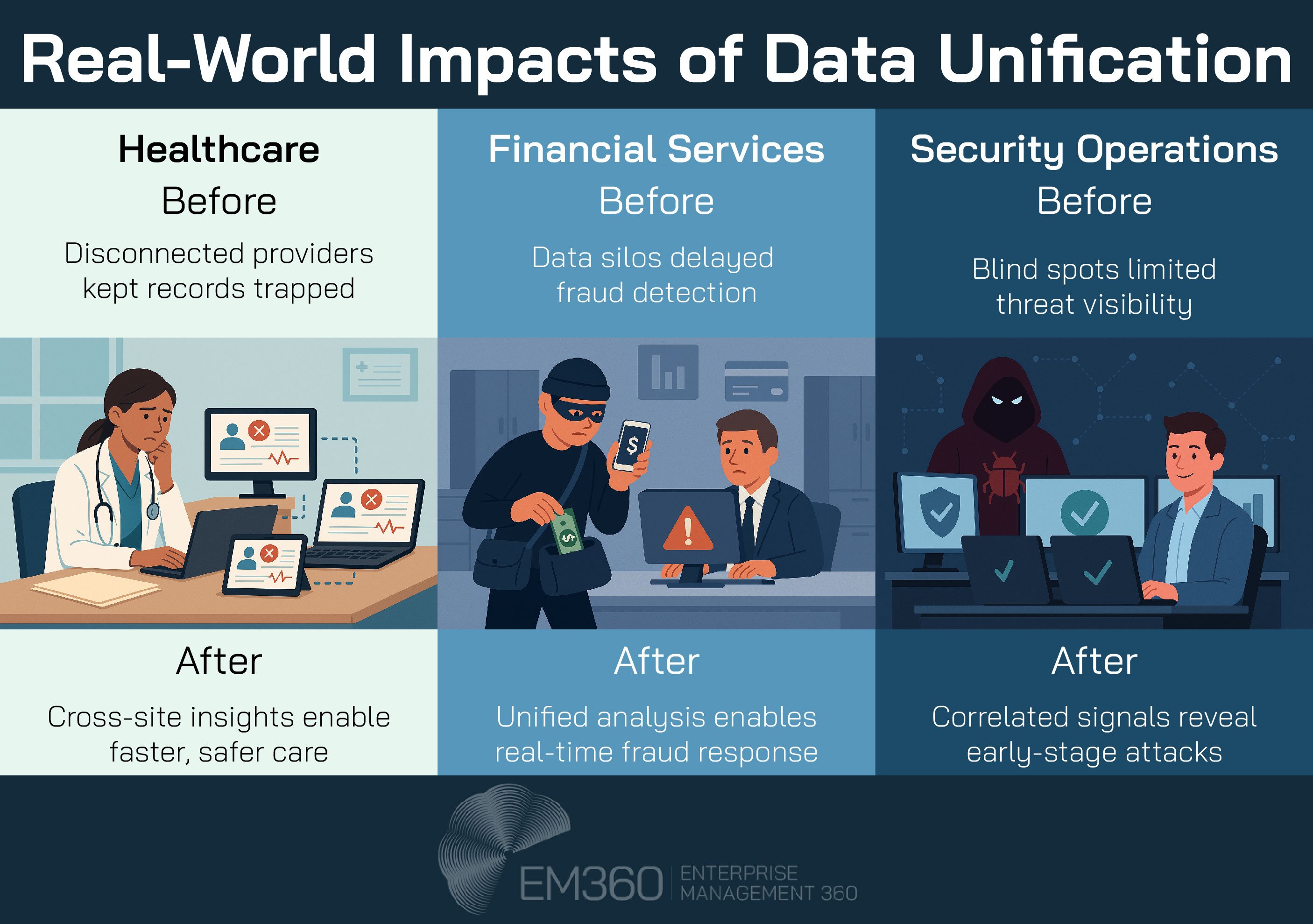
Healthcare: From fragmented records to connected care
In healthcare, siloed data can delay diagnoses, interrupt treatment, or lead to missed warning signs. Patient data is often scattered across hospitals, labs, specialists, and systems — none of which talk to each other.
By adopting federated learning models and secure data-sharing frameworks, healthcare networks are starting to enable cross-domain insights. Hospitals can now analyse outcomes across multiple sites without exposing sensitive records. Which improves diagnostic accuracy, helps with identifying population health trends, and also reduces errors in medication reconciliation.
The result? Better care coordination, faster interventions, and more complete visibility into the patient journey.
Financial services: Smarter fraud detection through data unification
Fraud detection lives or dies on timing. And in siloed financial systems, that timing often fails.
Banks and fintechs are using industry-specific solutions — from graph analytics to real-time alerting systems — to unify customer data across channels and subsidiaries. That means fraud signals in mobile banking can be linked to credit card anomalies without waiting on manual review or cross-department sync.
With shared access to behavioural patterns, institutions are reducing false positives, improving customer experience, and catching fraud before money moves.
It’s not just integration. It’s acceleration.
Security Ops: Seeing more means responding faster
In cybersecurity, silos create blind spots. And blind spots create breaches.
Security operations, or SecOps, teams are now deploying integrated observability platforms that ingest logs, alerts, and telemetry from across the IT landscape — including endpoints, networks, applications, and third-party tools.
This use case integration helps analysts see the full picture, correlate activity in real time, and shorten mean time to detect (MTTD) and respond (MTTR).
An isolated security event might not trigger an alarm. But when combined with dozens of smaller anomalies across systems, it reveals the early stages of a coordinated attack.
That’s the power of data without walls.
How to Prevent Silos in the Future: Best Practices for Resilient Data Strategy
Breaking down data silos is one thing. Making sure they don’t come back is another.
It’s easy to treat silo elimination as a one-time IT project — a migration, a data management platform rollout, or a dashboard refresh. But unless the way your organisation handles data fundamentally changes, those walls will rebuild themselves. Slowly. Quietly. Inevitably.
Here’s how to stop that from happening.
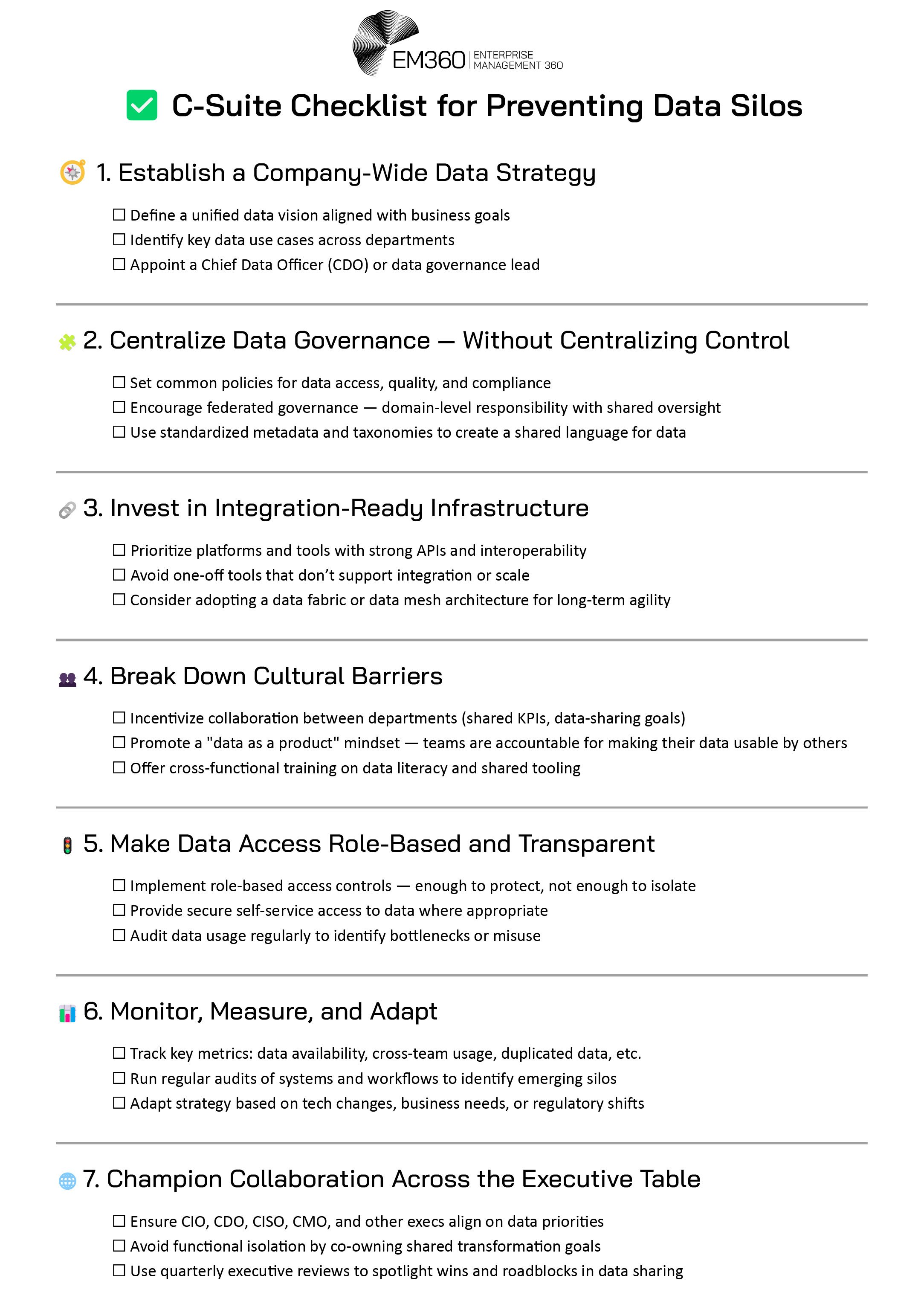
Build governance into the foundations
Data silos thrive in environments where ownership is unclear and rules are inconsistent. That’s why strong, proactive data stewardship is non-negotiable. Not just policies in a PDF, but living frameworks that define:
- Who owns each dataset
- Who can access what (and why)
- What quality, lineage, and auditability standards apply
A good data governance framework doesn’t restrict access — it clarifies it. And that clarity is what prevents fragmentation over time.
Foster a culture of transparency and data literacy
Even the best architecture can’t outpace a siloed mindset. If teams don’t know how to work with data — or don’t trust what they see — they’ll find their own tools, build their own reports, and slip right back into isolation.
A collaboration-first culture starts with data democratisation. This means providing people not only with access to data but also with the ability to understand, explore, and use it confidently.
That means investing in training. Clarifying definitions. Aligning metrics. And encouraging curiosity instead of gatekeeping.
When everyone speaks the same data language, collaboration stops being a workaround. It becomes the default.
Design for integration, not just functionality
Finally, every new system, platform, or tool you bring in should be vetted for interoperability. Because even the most powerful tech stack won’t help you if it creates another island.
Future-ready organisations prioritise unified tooling and architecture design — choosing platforms that plug into broader ecosystems, support open standards, and scale across departments without recreating silos in a shinier package.
This isn’t about centralising everything. It’s about connecting everything.
The Future of Enterprise Data: Toward Unified, AI‑Ready Infrastructure
We’re not just dreaming about interconnected data—we’re already building it. In tomorrow’s organisation, unified data infrastructure isn’t optional; it’s strategic. It'll define how fast you move, how smart you operate, and how well you scale.
These converging trends are reshaping the terrain:
1. DevOps + MLOps = Unified pipelines
Where once DevOps and MLOps lived in separate worlds, they’re now converging into a unified software supply chain. That means shared CI/CD pipelines, version control, and governance frameworks across both code and models—breaking down internal silos between developers, data scientists, and ops teams.
Why it matters: 85% of ML models never reach production. This integration ensures AI initiatives don’t stall in silos but flow through governed, repeatable delivery pipelines.
2. PlatformOps & AIOps: Orchestrating data & operations
PlatformOps combines DevOps, DataOps, and MLOps into a cohesive platform strategy that removes tooling and organisational silos.
AIOps brings AI into IT operations—correlating log data, automating incident response, and shrinking blind spots created by disconnected systems.
Why it matters: This creates unified visibility across apps, data, and infrastructure—shoring up security and reliability in modern hybrid-cloud environments.
3. Data mesh + Data fabric = “Data fabresh”
Originally positioned as alternatives, data mesh and data fabric are now appearing in hybrid manifestations known as data fabresh—a fusion layer that combines the decentralised ownership principle of a mesh model with the centralised metadata control of a fabric model.
Why it matters: It gives businesses the flexibility of domain-driven design, with the integration needed for AI, compliance, and federated analytics.
4. Federated learning + data mesh = Cross-domain insight
Integrating federated learning into mesh models allows decentralised data ownership without compromising privacy. It’s already showing promise across regulated sectors like healthcare and finance.
Why it matters: You get cross-domain intelligence without crossing boundaries—collaborative intelligence without compliance risks.
5. Data‑centric AI & real‑time intelligence
The shift toward real-time processing, data-centric AI, and knowledge graphs is demanding distributed intelligence at scale. Metadata, lineage, and quality are now mission‑critical.
Why it matters: Governance, trust, and context become baked into infrastructure—not afterthoughts.
Putting it all together: The AI‑ready infrastructure
These trends are more than buzzwords—they form the plumbing of a new age:
| Trend | Core Benefit |
| Mesh + Fabric | Distributed ownership and unified metadata |
| DevOps + MLOps | Reliable, governed model delivery pipelines |
| PlatformOps + AIOps | Operational integration and threat visibility |
| Federated Learning + Mesh | Privacy-compliant cross-domain AI |
| Real‑time & data‑centric AI | Contextual, governed intelligence at speed |
When woven together, these approaches create what we call AI‑ready architecture: a unified foundation that supports dynamic decision-making, secure deployment, and real-time insight.
The bottom line: a unified enterprise data strategy isn’t just a nice-to-have—it's the only way to accelerate with confidence. You’re not reforming operations; you’re reimagining possibility.
Other Frequently Asked Questions About Data Silos
Even with a solid understanding of data silos, some questions still come up time and again — especially from business leaders trying to connect technical priorities to real-world impact. Here are some of the most common ones.
What’s the difference between a data silo and a data lake?
A data silo is a restricted dataset — typically controlled by one team or system and not easily shared across the organisation. A data lake, by contrast, is a central repository that stores raw data in its native format, usually for broad access and analysis.
In short: silos isolate; lakes consolidate.
Are data silos ever useful?
In rare cases, yes — such as when sensitive data needs to be deliberately separated for privacy or compliance reasons. But even then, silos should be intentional and well-governed. Unplanned silos almost always lead to inefficiencies, duplication, and missed insights.
What are common signs a business has data silos?
Look for:
- Duplicate reports or datasets stored in multiple tools
- Teams using different metrics for the same KPIs
- Difficulty accessing data owned by another department
- Mismatched dashboards and conflicting numbers
- Manual workarounds to pull data from multiple places
These are all red flags that your organisation may be suffering from siloed systems and visibility gaps.
Can small businesses have data silos?
Absolutely. Silos don’t require scale — just separation. Even a five-person team can fall into siloed habits if tools don’t integrate or if teams aren’t aligned on how data is shared and used.
The good news? Smaller businesses can often fix silos faster because fewer systems and people are involved.
Final Thoughts: Build for Connection, Not Containment
Data silos don’t start as strategy — they start as shortcuts. We introduce new tools here and separate processes there. But over time, those shortcuts harden into walls. And what was once convenient becomes constraining.
Breaking them down takes more than a migration. It takes a mindset shift. One that treats data as a shared asset, not a departmental resource. One that values governance, trust, and accessibility as much as performance.
Because the future of enterprise data isn’t just unified — it’s intelligent, secure, and built to scale. And the organisations that lead that future will be the ones that design for connection, not containment.
If you’re rethinking your approach to data strategy, you’re not alone. EM360 is here to help you with taking the next step in your data management strategy, whether it involves exploring new technologies, keeping up with the latest trends, or learning from industry leaders who are already breaking new ground.














Comments ( 0 )